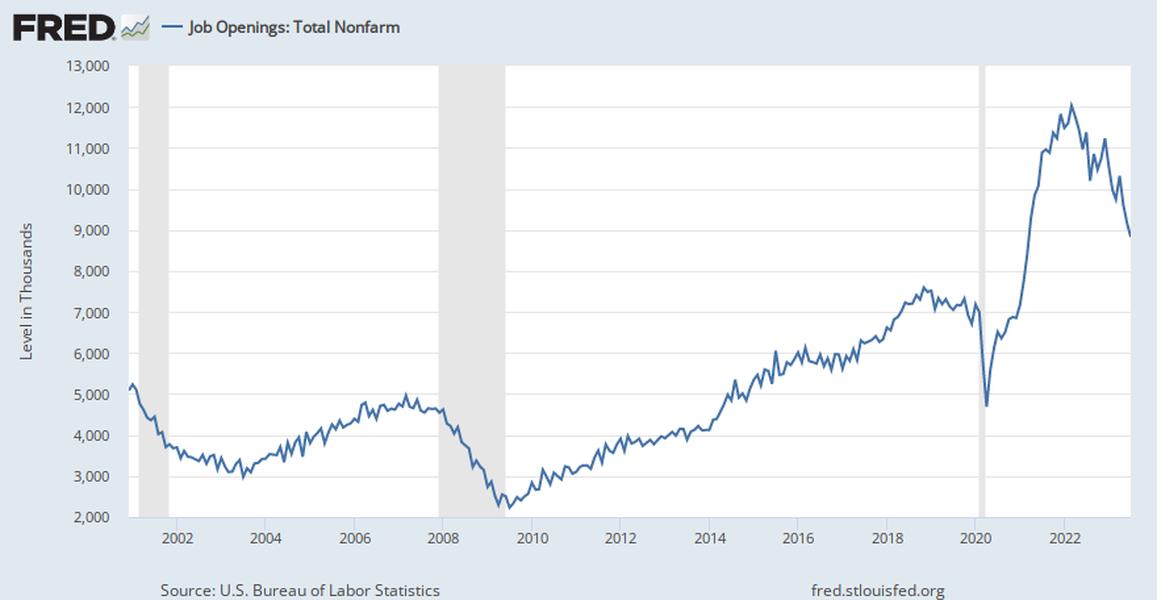What are the main reasons behind the slowdown in job growth?
The main reasons behind the slowdown in job growth can be attributed to a combination of factors. Firstly, the end of the Great Resignation has resulted in a shift in the dynamics of the job market. Many workers who were searching for new opportunities during the Great Resignation have now found employment, resulting in a decrease in job openings. Additionally, the ongoing labor shortage and increased competition for workers have made it challenging for businesses to fill vacant positions, leading to slower job growth. Furthermore, certain sectors such as professional and business services, health care and social assistance, state and local government, and federal government, have experienced a decrease in job openings, further contributing to the overall slowdown in job growth. However, it’s important to note that job openings in other sectors, such as information and transportation, warehousing, and utilities, have seen an increase, indicating a mixed pattern in job growth across different industries.
How has the Great Resignation impacted the employee-employer relationship?
The Great Resignation has had a profound impact on the employee-employer relationship. During this period, millions of workers have chosen to quit their jobs in search of better pay, improved benefits, and more flexibility. This surge in resignations has put significant pressure on employers to adapt and make changes to attract and retain talent. Companies, both large and small, have had to reevaluate their compensation packages, offer more competitive wages, and provide additional benefits to entice employees to stay. Moreover, the Great Resignation has highlighted the importance of work-life balance and the desire for more control over one’s professional life. As a result, many organizations have embraced remote work options, flexible schedules, and other initiatives to accommodate the changing preferences and needs of their employees. This shift in the employee-employer relationship has emphasized the importance of mutual respect, open communication, and a greater focus on employee well-being and satisfaction.
What insights can be gained from the Atlanta Fed’s Wage Growth Tracker regarding the job market?
The Atlanta Fed’s Wage Growth Tracker offers valuable insights into the job market by providing a comprehensive view of wage dynamics. The data collected from the monthly Current Population Survey includes various employment and demographic characteristics, allowing for a detailed analysis of wage growth trends. By tracking wage growth, economists and policymakers can gain insights into the overall health of the job market. For example, if wage growth is stagnant or declining, it may indicate a slowdown in job market conditions and a decrease in demand for labor. On the other hand, significant wage growth can point to a tightening labor market and increased competition for skilled workers. The Wage Growth Tracker also enables the identification of wage disparities across industries and demographic groups, highlighting areas where there may be a need for targeted interventions or policy adjustments to promote equitable wage growth. Overall, the Atlanta Fed’s Wage Growth Tracker provides important data and insights that can inform decision-making and strategy development in relation to the job market.
Full summary
The job market is continuously evolving, and it's important for job seekers and economists to stay updated on the latest trends. In this article, we will explore the main events in the job market and how they impact the economy. We will also discuss the insights from extra sources that provide a comprehensive view of the current state of the job market.\n\n" + "Job growth is slowing, but the reasons behind this slowdown are not necessarily negative. Unemployment is up, but it's important to understand the context behind this change. The great resignation has come to an end, indicating a shift in the dynamics of the job market. However, job openings are rapidly approaching normal levels, which is a positive sign.\n\n" + "The number of job openings edged down to 8.8 million in July, but there were still 5.8 million hires and 5.5 million total separations. Within total separations, quits decreased, while layoffs and discharges remained relatively stable. Job openings decreased in certain sectors, such as professional and business services, health care and social assistance, state and local government, and federal government. On the other hand, job openings increased in information and transportation, warehousing, and utilities.\n\n" + "The share of searches for $20 wages has grown significantly, indicating a shift in job seekers' expectations. Wage gains and inflation play a role in this behavior. Despite some cooling, the US labor market remains hot, with job postings on Indeed well above their pre-pandemic baseline. However, postings are gradually pulling back, especially in remote sectors.\n\n" + "The labor force and unemployment rates have been closely monitored. Total nonfarm payroll employment increased in August, but the unemployment rate also rose. Employment continued to trend up in health care, leisure and hospitality, social assistance, and construction, while employment in transportation and warehousing declined. The number of unemployed persons increased, but the rates for different demographic groups showed little change.\n\n" + "Research has shown a positive relationship between job-to-job mobility and inflation, which has been observed during the Great Resignation. The surge in job searches while employed has contributed to raising inflation. This trend depends on various factors, including changes in the propensity of employed workers to search for new jobs.\n\n" + "The Great Resignation has had a significant impact on the employee-employer relationship. Millions of workers have quit their jobs, seeking higher pay, greater benefits, and more freedom. This trend has persisted and has resulted in changes for small businesses as well. Strategies to attract and retain employees have been crucial.\n\n" + "Total nonfarm job openings serve as a measure of tightness within job markets. The number of job openings may decline due to positions being filled or removed without filling. Job openings rates and separations rates have fluctuated in different states.\n\n" + "Lastly, the Atlanta Fed's Wage Growth Tracker provides valuable insights into the wage dynamics in the job market. The data is obtained from the monthly Current Population Survey and includes various employment and demographic characteristics. Understanding wage growth is essential for analyzing the overall health of the job market.\n\n" + "In conclusion, the job market is constantly evolving, and it's important to stay updated on the latest trends and insights. From slowing job growth to the impact of the Great Resignation, these events provide valuable information for job seekers, economists, and businesses. By understanding the dynamics of the job market, we can make informed decisions and adapt to the changing landscape.


















